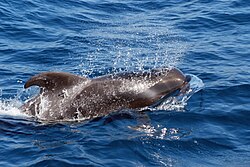The American Museum journal (c1900-(1918)) (17974492419)
Title: The American Museum journal
Identifier: americanmuseumjo14amer (find matches)
Year: c1900-(1918) (c190s)
Authors: American Museum of Natural History
Subjects: Natural history
Publisher: New York : American Museum of Natural History
Contributing Library: American Museum of Natural History Library
Digitizing Sponsor: Biodiversity Heritage Library
View Book Page: Book Viewer
About This Book: Catalog Entry
View All Images: All Images From Book
Click here to view book online to see this illustration in context in a browseable online version of this book.
Text Appearing Before Image:
'
Text Appearing After Image:
Pacific blackflsh (Globiocephalus scammoni). This is a very rare species and practically nothing has been known hitherto of its external characteristics server. These specimens were nearly always in a more or less advanced state of decomposition and badly bloated by gases so that little of their true form remained. All Cetaceans change color very rapidly after death and unless the animal is seen before it has been exposed to the air, accurate descriptions of its color in life cannot be obtained. For instance, the Atlantic finback for many years has been described as "black" although it is never black in life. When the work of the Vancouver Island stations was finished I went northward to study finbacks at Tyee, on Admiralty Island, Alaska, for at the southern stations only humpback, blue and sperm whales had been taken. I came back to New York in the fall with much information about the Pacific whales and an intense desire to continue the work. An opportunity soon pre- sented itself and the following June 284 I went to Quebec to study and collect the beautiful "white whale," the marsouin hlanc of the French dwellers along the St. Lawrence River. Although this species is a true ice porpoise and is never found where the water is far above the freezing point, yet early in the spring the animals come into the St. Lawrence River by thousands, their white bodies looking more like foamy wave crests than things of life. They are hunted for their skins which give the "porpoise hide" of commerce, each animal being worth about seven dollars. The whales were killed by first shoot- ing them with a heavy musket as they rose to blow, then paddling up in a small canoe and throwing a harpoon as they thrashed their white lengths about upon the water. The first whale we killed was a full-grown male absolutely pure white, except for a narrow grayish edging on the flukes and fins. It was
Note About Images
Relevantní obrázky





















Relevantní články
Kulohlavec SieboldůvKulohlavec Sieboldův je středně velký kytovec z čeledi delfínovití (Delphinidae) a jeden ze dvou zástupců kulohlavců. Má rozsáhlé rozšíření v oceánech tropického, subtropického i teplejší části mírného pásu. U evropských břehů se s ním lze setkat hlavně u Azorů, Madeiry a Kanárských ostrovů. Ve Středozemním moři se nevyskytuje, tam jej nahrazuje kulohlavec černý. Oba druhy kulohlavců si jsou extrémně podobné, kulohlavce Sieboldova lze při bližším prozkoumání odlišit díky kratším hrudním ploutvím, širší lebce či většímu počtu zubů. .. pokračovat ve čtení
